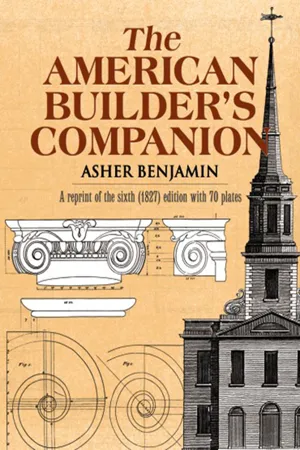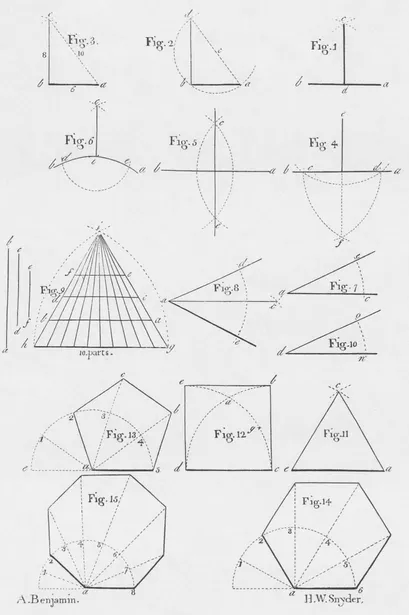PLATE I.
PRACTICAL GEOMETRY.
DEFINITIONS.
GEOMETRY, is that Science which treats of the discriptions and proportions of magnitudes in general.
A point is that which has position, but no magnitude nor dimensions; neither length, breadth, nor thickness, as A.
A right line, is length without breadth or thickness, as 1.
A mixed line, is both right and curved, as 2.
A curve line continually changes its direction between its extreme points, as 3.
Parallel lines are always at the same perpendicular distance ; and they never meet though ever so far produced, as 4 and 5.
Oblique right lines change their distance, and would meet, if produced, on the side of the least distance, as 6.
One line is perpendicular to another, when it inclines not more on the one side than the other ; or when the angles on both sides of it are equal, as 7.
A surface, or superfices, is an extension, or a figure, but without thickness, as 8.
A body, or solid, is a figure of three dimensions ; namely, length, breadth, and thickness, as 9.
A line, or a circle, is tangential, or a tangent to a circle, or other curve, when it touches it without cutting, when both are produced, as 10.
An angle is the inclination, or opening of two lines, having different directions, and meeting in a point, as 11.
A right angle is that which is made by one line perpendicular to another, or when the angle on each side are equal to one another, as the lines a b, and a c, on 16.
An acute angle is less than a right angle, as 12.
An obtuse angle, is greater than a right angle, as 13.
Plain figures that are bound by right lines have names according to the number of their sides, or of their angles ; for they have as many sides as angles ; the least number being three. A figure of three sides and angles, is called a triangle, as 14,15,16, and 17; and they receive particular denominations from the relations of their sides and angles.
An equilateral triangle, is that whose three sides are all equal, as 14.
A right angled triangle, is that which has one right angle, as 16.
An isosceles triangle has only two sides equal, as 15.
A scalene triangle has all sides unequal, as 17.
An obstuse angled triangle has one obstuse angle, as 17.
Of four sided figures their are many sorts ; as the square 18, which is a plain regular figure, whose superfices are limited by four equal sides, all at right angles with one another.
The parallelogram 19, receives its name from its opposite sides and ends, being parallel to each other; the parallelogram is also called a long square, or oblong, in consequence of its being longer than it is wide.
The rhomboids 20, is an equilateral parallelogram, whose angles are oblique, as 20.
A trapezium is a quadrilateral, which has neither of its sides parallel, as 21.
A trapezoid hath only one pair of its opposite sides parallel, as 22.
Plane figures having more than four sides are in general called polygons, and receive other particular names, according to the number of their sides or angles.
A pentigon, is a polygon of five sides, as fig. 13, plate 2.
A hexigon, is a polygon of six sides, as fig. 14, plate 2.
A heptagon has seven sides; an octagon eight; a nonagon nine ; a decagon ten; an undecagon eleven ; and a dodecagon twelve.
A regular polygon has all its sides and its angles equal; and if they are not equal the polygon is irregular.
An equilateral triangle is also a regular figure of three sides, and a square is one of four; the former being called a trigon, and the latter a tetragon.
A circle, is a plain figure, bounded by a curve line, called the circumference, which is every where equidistant from a certain point within, called its centre.
The radius of a circle, is a right line drawn from the centre to the circumference, as a b, 23.
A diameter of a circle, is a right line drawn through the centre, terminating on both sides of the circumference, as c d, on 23.
An arch of a circle is any part of the circumference, as a b, 24.
A chord is a right line joining the extremities of an arch, as a b, 24.
A semicircle, is half the circle, or a segment cut off by diameter, as c d, 25.
A section, is any part of a circle, bounded by an arch and two radii, drawn to its extremities, as 26.
A quadrant, or quarter of a circle, is a sector, having a quarter of the circumference for its arch, and the two radii are perpendicular to each other, as c a, and o c, 27.
The measure of any right lined angle, is an arch of any circle contained between the two lines, which form the angle, and the angular point being in the centre, as 30.
The height, or altitude of any figure, as perpendicular let fall from an angle or its vertex to the opposite side, called the base, as the line, a b, 28.
When an angle is denoted by three letters, the middle one is the place of the angle, and the other two denote the sides containing that angle ; thus, let a b d, be the angle at 29, b is the angular point, a b and b d, are the two sides containing that angle.
PLATE II.
FIG. 1.
To draw a perpendicular to a given point in a line. a b is a line, and d a given point; take a and b, two equal distances on each side of d, and with your compasses in a and b, make an intersection at c, and draw c d, which is the perpendicular required.
FIG. 2.
To erect a perpendicular on the end of a line. Take any point you please above the line, as c, and with the distance c b, make the arch, a b d, and draw the line a c, to cut it at d, and draw d b, the perpendicular.
FIG. 3.
To make a perpendicular with a ten foot rod. Let b a be six feet; take eight feet in your compasses ; from b make the arch c, with the distance ten feet from a ; make the intersection at c, and draw the perpendicular, c b.
FIG. 4.
To let fall a perpendicular from a given point in a line. In the point e make an arch to cross the line a b, at c d ; with the distance c d, make the intersection f, and draw e f, the perpendicular.
FIG. 5.
To divide a line in two equal parts by a perpendicular. In the points a and b, describe two arches to intersect at c and e, and draw the line c e, which makes the perpendicular required.
FIG. 6.
To erect a perpendicular on the segment of a circle, a b. From i draw the arch e d ; and, with the distance, c d, and on c and d, make the intersection c, and draw the perpendicular c i.
FIG. 7 and 10.
An angle being given, to make another equal to it from a point, in a right line. Let a, c, e, be the given angle, and d n, a right line ; d the given point ; on a make an arch c e, with any radius, and on d, with the same radius, describe an arch, n o ; take the opening, c e, and set it from n to o, and draw o d, and the angle will be equal to that of a, c, e.
FIG. 8.
To divide any given angle into two equal parts. On a, the angular point, with the radius, a e, or any other, make the circle e d ; on e and d, with the radius e c, make the intersection c, and draw the line c a, which is the division required.
FIG. 9.
To divide a right line given, into any number of equal parts. Let a b, be a given line, to be divided into ten equal parts ; take any distance in your compasses, more than one tenth of that line, and run them off on the line h g, and with that distance, make the triangle h, i, g, and draw each tenth division to the angle i ; take the length of the given line a b, and set one foot of the compasses at a, on the line g, i, and let the other fall on the line h i, at b, parallel to h g, and draw the line a b, which gives the ten divisions required ; the lines d c, and f e, or any others which are shorter than the base line of the triangle, can also be drawn across it, which when done, will be divided into tenths.
FIG. 11.
To make an equilateral triangle upon a right line. Take a e, the given side, in your compasses ; and on a and e, make the intersection c, and draw a c, and e c.
FIG. 12.
To make a geometrical square upon a right line. With the given side d c, and in the points d and c, describe two arches to intersect at a ; divide a c, into two equal parts at g ; make a e, and a b, each equal to a g, and draw c b, d. e, and e b.
FIG. 13, 14, and 15.
The sides of any polygon being given to describe the polygon to any number of sides whatever. On the extreme of the given side make a semicircle of any radius, it w...

